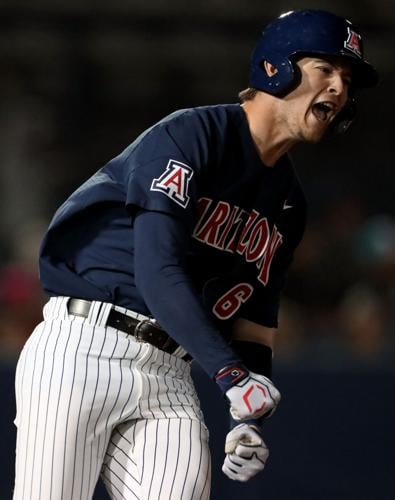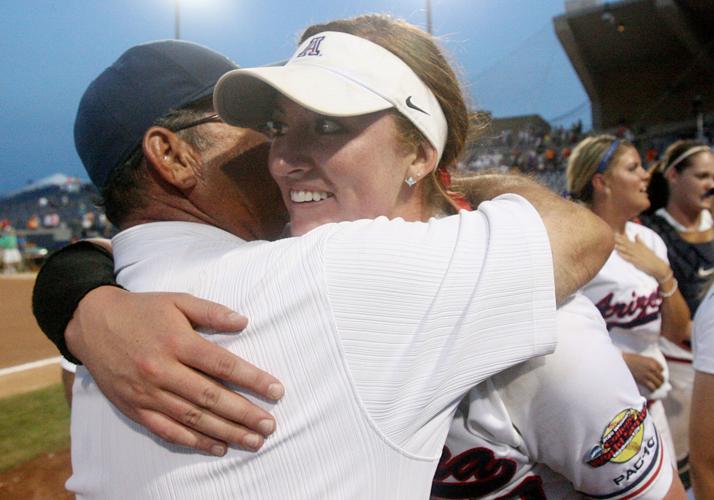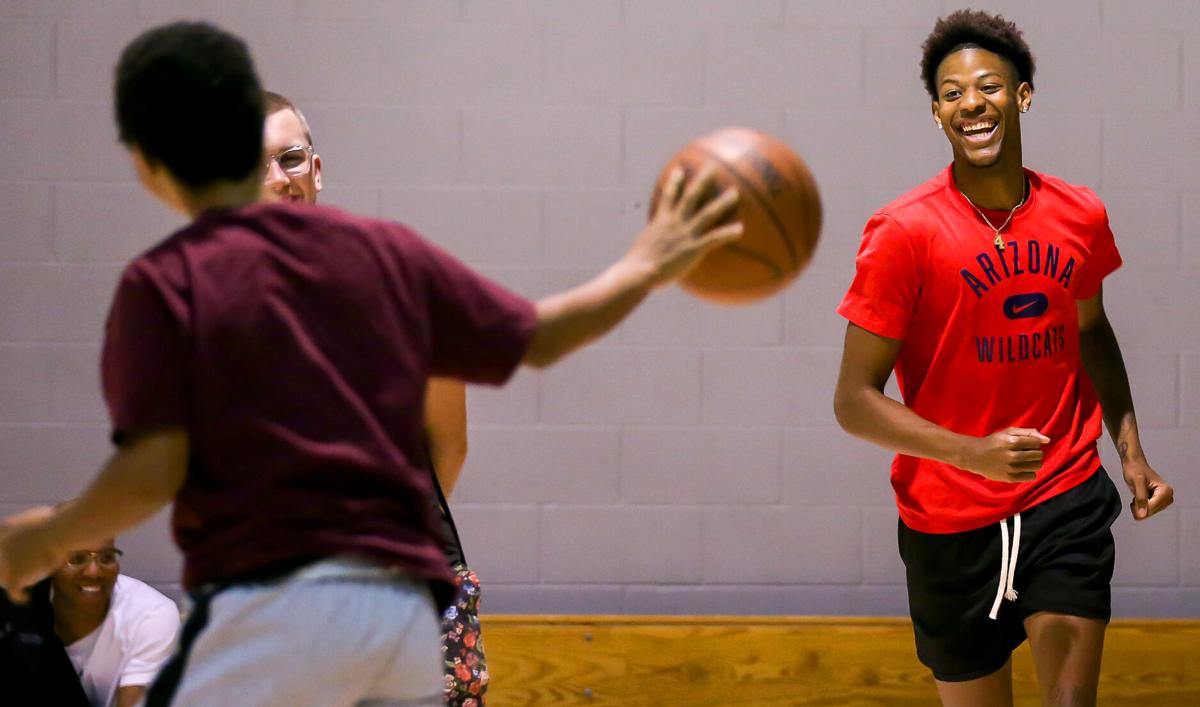The Star's longtime columnist checks in updates on Dalen Terry's NBA chances, Arizona's radio presence, Kenzie Fowler Quinn's career and college football's future.

The backboard buzzer-light flashes at the end of regulation with Arizona Wildcats guard Dalen Terry (4) inches short of a game winning dunk, with the game tied at 75 against the TCU Horned Frogs during their NCAA Tournament game against TCU.
NBA clubs can help Terry develop
When the Cleveland Cavaliers hired Luke Walton to be an assistant coach last week, it was Exhibit A of how the NBA has changed and, more so, how that growth is making room for more not-ready-for-prime-time prospects like Arizona’s Dalen Terry.
Walton is one of six Cavaliers assistant coaches. Yes, six! He joins a highly populated, development-based staff that includes a separate shooting coach, three full-time player development coaches and a director of player development.
If you are not a lottery pick in the NBA, the successful teams who draft later, like the Warriors and Celtics, do not need immediate help. The model has changed. The NBA has a minor-league system, somewhat like in baseball, and it allows time for someone like Terry, who needs to improve his shooting and ball-handling skills, to get playing time in the NBA.
The Warriors’ starting center, Kevon Looney, is a good example. Looney was selected 30th out of UCLA in the 2015 NBA draft by Golden State’s growing powerhouse franchise. His first two seasons he averaged 4 and 8 minutes per game. He only started eight games his first three seasons.
But now Looney is a useful piece; he started 80 games this season. Terry fits that development model.
When Terry announced he would stay in the draft last week, my initial thought was that he could develop better with a junior season at Arizona. He would’ve been a go-to player. But given he’ll likely be paid a minimum of $500,000 with a two-way G-League contract (and likely four times that, minimum), Terry won’t miss the free services provided by Arizona: a trainer, a doctor, workout facilities and access to a nutritionist and psychologist. Now he can hire his own, or use those of the team that drafts him.
Over the last 15 years, I thought the two Wildcat basketball players who made the biggest mistakes by jumping to the NBA draft were forward Marcus Williams (2007) and Grant Jerrett (2013). They were clearly long-range NBA prospects, but they left too soon. Williams was the 33rd overall choice but only played in 13 NBA games. His support and development staff was nowhere what a college player would have today.
Jerrett was the 40th overall selection. He played in just eight NBA games. And although he has probably made a significant amount of money playing in Japan, China, Turkey, Germany and Russia (before play was stopped in mid-season this year), he had the potential for a full NBA career, in my opinion.
I don’t blame Terry for leaving Arizona. Playing college basketball at a school like Arizona has become a NBA preparatory school. You don’t often circulate among the student body, you don’t spend time in the student union, fraternizing with buddies. It is almost a 24/7 prep for a professional future.
In other words, being a college student at a Top-25 basketball school isn’t what it was when Steve Kerr or Damon Stoudamire attended Arizona for a total of nine years. You got the full campus experience in the ’80s and ’90s. Today, the lure of the NBA is greater than the pomp and circumstance of a McKale Center showdown against UCLA or of March Madness. You spend the great majority of your time with academic advisors, trainers, shooting jumpers or in the weight room.
You probably never find out where Centennial Hall is or learn who Button Salmon and the "The Cactus Comet" were.
Best of luck to Dalen Terry. If he is indeed a late first-round draft pick, his support system will all but make sure he’ll develop and someday get a crack at significant playing time.
More draft news:
• It seems like ages ago that Corona del Sol High School basketball whiz Alex Barcello was Arizona’s Gatorade Player of the Year (2015 and 2017) in boys basketball. His Arizona career didn’t work out. Barcello was given a short leash by Sean Miller, averaging just 2.4 and 3.3 points per game. But when he transferred to BYU, Barcello made the most of a second chance. He averaged 9.3, 16.1 and 16.8 points for the Cougars and played with a joy that didn’t surface at Arizona. In the last few weeks, Barcello has worked out for the Washington Wizards, the San Antonio Spurs and the Utah Jazz. Could he be the next T.J. McConnell? It wouldn’t be a shock. Barcello turns 24 in August and is one of those glue-guys — like McConnell — who could find a spot on an NBA roster for a long time.

Arizona outfielder Paige Dimler (22) makes a diving catch for an out during the third inning of the team's NCAA softball Women's College World Series game against Oregon State on Friday, June 3, 2022, in Oklahoma City.
Wildcats women belong on radio
Early Friday evening, while driving across town, I turned the radio to Tucson’s three sports radio stations — 1490-AM, 1450-AM and 1290-AM — and got nothing but chatter about the NBA Finals and NFL quarterbacks.
Arizona’s compelling victory over Oregon State at the Women’s College World Series did not get any radio coverage in Tucson. That seems out of place on the month of the 50th anniversary of Title IX, which was aimed at giving women’s college sports equal treatment to men’s sports. And it remains doubly puzzling because Arizona is the nation’s No. 1 college softball franchise, with eight NCAA championships.
Of the eight schools in the WCWS, four provided game-by-game radio coverage of their softball teams this season: Florida, Oklahoma, Texas and Oklahoma State.
Arizona infrequently broadcasts a home game from Hillenbrand Stadium, but, by comparison, it fully staffs the UA baseball program with radio coverage on 1290-AM, home and road. Brian Jeffries is in Florida this weekend to broadcast the NCAA baseball regionals.
I’ve long thought that interest in UA softball and baseball in Tucson is close to a 50/50 split. The baseball team averaged 3,936 fans at Hi Corbett Field this season; the softball team averaged 2,761 at Hillenbrand Stadium, which is essentially a sellout. Maybe it’s the crowd I circulate in, but I hear more public chatter about UA softball than UA baseball.
Putting Arizona softball on radio, game by game, home and road, is long overdue.
More softball:
• Arizona is just the second Pac-12 softball team to finish in last place in the regular season (8-16, tied with Cal) to reach the Women’s College World Series. The other was ASU’s 1999 team, which went 8-20 in the conference. How did it finish 8-20 and still get a bid to the postseason? Easy. All 20 of ASU’s conference losses that season were against teams ranked no worse than No. 16 in the Top 25 on the day of the game. Four of those ’99 teams — Arizona, UCLA, Washington and Stanford — were regularly ranked in the top 10. ASU went 0-2 in the ’99 World Series.
• To get an idea of how much money the NCAA has, picture this: it must pay the road expenses for Arizona (and all other post-season softball teams) from start to finish. For a team like Arizona — the Wildcats have been on the road since May 18 — that comes close to $400,000. Do the math: a traveling party of about 40 people, requiring three charter flights, about 25 hotel rooms per night, three meals per day and ground transportation. It adds up in a hurry.
Zags' Drew Timmie once visted Cats
The new "target" for Top-25 basketball programs should be someone like Gonzaga senior-to-be Drew Timme, who last week ended his examination of the NBA Draft and returned for a final season at Gonzaga. He could be the most valuable player in college basketball next season. Timme visited Arizona the first week of November 2018, a four-star recruit from Richardson, Texas. But Arizona was loaded; it signed Christian Koloko, Josh Green, Zeke Nnaji and Nico Mannion in the Class of 2019 and didn’t think it would miss the 6-foot-8-inch Timme. Oops. Timme is considered a "tweener" by the NBA, not quite tall enough, quick enough nor a strong 3-point shooter. All he does is win. He’s like Oregon State’s Tres Tinkle from a few years ago, but better. Timme has scored 1,521 points for the Zags.
Ex-Cat Jacob Berry a second-teamer at LSU
A year ago, Arizona freshman switch-hitter Jacob Berry was a first-team All-American, hitting .352 with 17 homers and 70 RBIs. This year, after transferring to LSU, Berry only made the All-SEC second team, even though his numbers are terrific, with 15 homers and 48 RBIs. He is only fourth on coach Jay Johnson’s team in RBIs. A lot of that is because the SEC is superior to Pac-12 baseball across the board.

Arizona catcher Daniel Susac rounds first base after hitting a three-run homer in the Wildcats’ March 8 game against New Mexico. Susac, a former quarterback, has a photographic memory and an intricate knowledge of how both baseball and football work.
UA's Daniel Susac looks like a high pick
Arizona sophomore catcher Daniel Susac probably won’t be a first-team All-American this season, even though he entered the NCAA regionals hitting .367 with 12 homers and 61 RBIs. That’s because Georgia Tech catcher Kevin Parada hit .356 with 25 homers and 85 RBIs. Parada is generally predicted to be one of the first five players chosen in the MLB draft. Susac is more likely to be picked between Nos. 10-20. Arizona has a strong history of first-team All-American catchers, starting with Tucson High grad Bob Murray in 1950. He has been followed by first-team catchers Alan Hall, 1960; Dennis Haines, 1974; and Alan Zinter, 1989. Arizona’s second-team All-American catchers were Lloyd Jenney, 1952; Nick Hundley, 2005, with Tucson High’s Willie Morales, 1993, and J.K. Rokey, 1970, being third-team All-Americans.

Kenzie Fowler Quinn and the UA won four games in two days to climb from the losers bracket to the 2010 WCWS championship series.
Kenzie Fowler Quinn is PCSHOF-bound
It is good to see Kenzie Fowler Quinn back in Oklahoma City at the Women’s College World Series. The two-time national Gatorade softball player of the year while at Canyon del Oro High School, 2008 and 2009, is in OKC in her role for the UA’s creative services, a video production specialist. Pat Darcy of the Pima County Sports Hall of Fame announced last week that Fowler Quinn has been selected to the Class of 2022 for the PCSHOF. She will be inducted in November at a banquet at the DoubleTree Hotel. Fowler Quinn pitched Arizona to the championship game of the 2010 WCWS before injuries derailed her status as the game’s leading pitcher. She has also become perhaps the top Pac-12 Networks softball analyst over the last few seasons.
Jerry Foltz joins LIV Tour
Jerry Foltz, an All-Pac-10 golfer at Arizona in 1984, has been Golf Channel’s main on-course reporter for the LPGA Tour, as well as a studio host, since 1999. That all came to an end last week when Foltz chose to leave Golf Channel to join the Saudi Arabia-backed LIV Tour, that begins this week in London. Foltz is expected to be the on-course reporter for the LIV Tour’s global broadcasts. Foltz skipped the ongoing U.S. Women’s Open coverage this week. After leaving Arizona, Foltz was injured in an automobile accident that stalled his efforts to reach the PGA Tour. He returned to Tucson and worked at the Cork restaurant for a year while regaining his golf form, qualifying for what is now the Korn Ferry Tour.
Clancy Shields lines up killer recruiting class
It could be that the top recruiting Class of 2022 at Arizona is coach Clancy Shields’ men’s tennis team. That’s not a surprise. Shields has recruited so well globally since becoming Arizona’s tennis coach five years ago that the Wildcats won a first-ever Pac-12 championship last month. Last week, tennisrecruiting.net, ranked Arizona’s Class of ’22 as No. 11 nationally. Shields’ class includes five-star prospect Dominique Rolland of Los Angeles, Jay Dylan Hara Friend of Japan, ranked No. 11 overall, and Eric Padgham of Australia, ranked No. 13 in the class. Impressive.
My two cents: OSU's NIL plans could sink schools like Arizona
Ohio State football coach Ryan Day met with Buckeyes donors last week and told them the football program needs about $13 million a year to fund name, image and likeness ventures for Buckeye players. He said it is the only way to remain competitive with SEC schools such as Alabama and Texas A&M.
If indeed that is the future of college football, it is almost certain that by, say, 2030, the current FCS system will fracture, and 25 or 30 super-football schools will break away into their own league.
There is no way Arizona or UCLA or ASU or Utah can come close to matching $13 million a year to pay its football players. One Pac-12 athletic director recently told me that he spent a full day last month driving his starting quarterback around town, visiting various auto dealerships in pursuit of an NIL partnership.
Welcome to college football 2022, like it or not.










